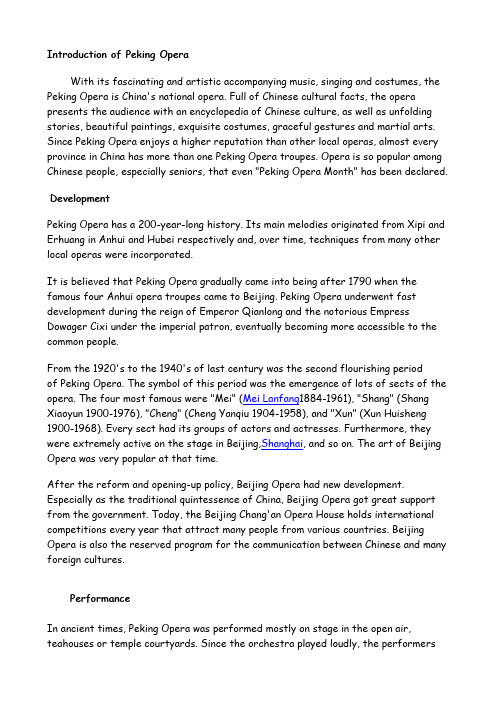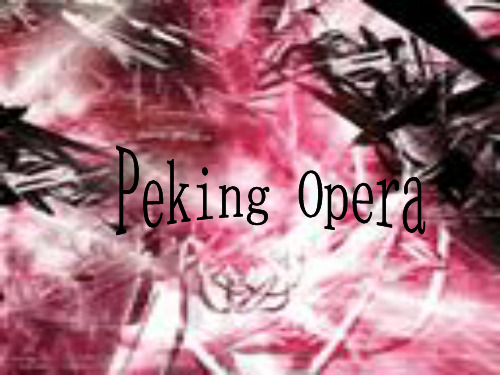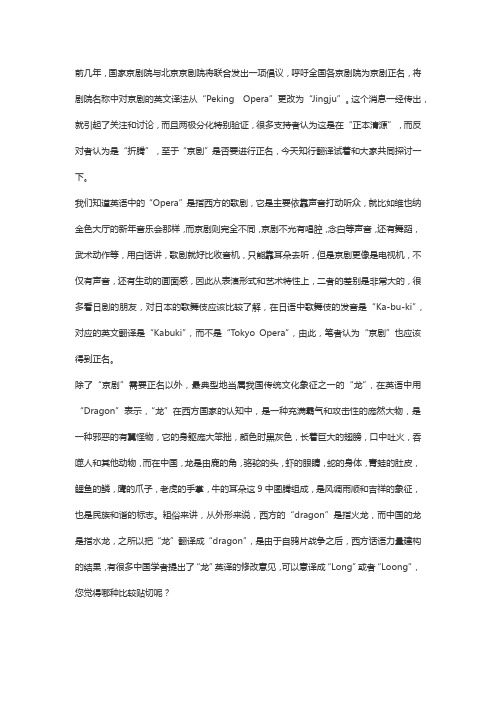PEKING OPERA EIGURINES
- 格式:pdf
- 大小:1.28 MB
- 文档页数:4


Introduction of Peking OperaWith its fascinating and artistic accompanying music, singing and costumes, the Peking Opera is China's national opera. Full of Chinese cultural facts, the opera presents the audience with an encyclopedia of Chinese culture, as well as unfolding stories, beautiful paintings, exquisite costumes, graceful gestures and martial arts. Since Peking Opera enjoys a higher reputation than other local operas, almost every province in China has more than one Peking Opera troupes. Opera is so popular among Chinese people, especially seniors, that even "Peking Opera Month" has been declared. DevelopmentPeking Opera has a 200-year-long history. Its main melodies originated from Xipi and Erhuang in Anhui and Hubei respectively and, over time, techniques from many other local operas were incorporated.It is believed that Peking Opera gradually came into being after 1790 when the famous four Anhui opera troupes came to Beijing. Peking Opera underwent fast development during the reign of Emperor Qianlong and the notorious Empress Dowager Cixi under the imperial patron, eventually becoming more accessible to the common people.From the 1920's to the 1940's of last century was the second flourishing periodof Peking Opera. The symbol of this period was the emergence of lots of sects of the opera. The four most famous were "Mei" (Mei Lanfang1884-1961), "Shang" (Shang Xiaoyun 1900-1976), "Cheng" (Cheng Yanqiu 1904-1958), and "Xun" (Xun Huisheng 1900-1968). Every sect had its groups of actors and actresses. Furthermore, they were extremely active on the stage in Beijing,Shanghai, and so on. The art of Beijing Opera was very popular at that time.After the reform and opening-up policy, Beijing Opera had new development. Especially as the traditional quintessence of China, Beijing Opera got great support from the government. Today, the Beijing Chang'an Opera House holds international competitions every year that attract many people from various countries. Beijing Opera is also the reserved program for the communication between Chinese and many foreign cultures.PerformanceIn ancient times, Peking Opera was performed mostly on stage in the open air, teahouses or temple courtyards. Since the orchestra played loudly, the performersdeveloped a piercing style of song that could be heard by everyone. The costumes were a garish collection of sharply contrasting colors to stand out on the dim stage illuminated only by oil lamps. Peking Opera is a harmonious combination of the Grand Opera, ballet and acrobatics, consisting of dance, dialogue, monologues, martial arts and mime.The Peking Opera band mainly consists of an orchestra and percussion band. The former frequently accompanies peaceful scenes while the latter provides the right atmosphere for battle scenes. The commonly used percussion instruments include castanets, drums, bells and cymbals. One person usually plays the castanets and drum simultaneously, which conduct the entire band. The orchestral instruments include the Erhu, Huqin, Yueqin, Sheng (reed pipe), Pipa (lute) and other instruments. The band usually sits on the left side of the stage.Facial PaintingIt is said that this special art derived from Chinese opera has different origins. But no matter what its origin, facial painting is worth appreciating for its artistic value. The paintings are representations of the characters' roles. For example, a red face usually depicts heroic bravery, uprightness and loyalty; a white face symbolizes a sinister, treacherous and guile character and a green face connotes surly stubbornness, impetuosity and lack of self-restraint. In addition, facial painting patterns reveal information about a character, as well. Essentially, the unique makeup allows characters on stage to reveal them voicelessly.Roles in Peking OperaIn Peking Opera, there are four roles: the male and female roles, the painted-face role, and the comedic role. These roles have the natural features of age and sex, as well as social status, and are artificially exaggerated by makeup, costume and gestures.Laosheng is also known as Xusheng, meaning bearded, because the actors wear artificial beards, as they are middle-aged or elderly men. Most are upright and resolute characters. They sing in their natural voices, and their actions are serious ones.Xiao sheng is a sub-category of Sheng representing young male characters. They don't wear artificial beards. They always sing in their real voices, while in Kunqu and Pihuang operas the singing mixes natural and falsetto voicesWu sheng stands for all of the male characters who appear in battle scenes.。


前几年,国家京剧院与北京京剧院将联合发出一项倡议,呼吁全国各京剧院为京剧正名,将剧院名称中对京剧的英文译法从“Peking Opera”更改为“Jingju”。
这个消息一经传出,就引起了关注和讨论,而且两极分化特别验证,很多支持者认为这是在“正本清源”,而反对者认为是“折腾”,至于“京剧”是否要进行正名,今天知行翻译试着和大家共同探讨一下。
我们知道英语中的“Opera”是指西方的歌剧,它是主要依靠声音打动听众,就比如维也纳金色大厅的新年音乐会那样,而京剧则完全不同,京剧不光有唱腔,念白等声音,还有舞蹈,武术动作等,用白话讲,歌剧就好比收音机,只能靠耳朵去听,但是京剧更像是电视机,不仅有声音,还有生动的画面感,因此从表演形式和艺术特性上,二者的差别是非常大的,很多看日剧的朋友,对日本的歌舞伎应该比较了解,在日语中歌舞伎的发音是“Ka-bu-ki”,对应的英文翻译是“Kabuki”,而不是“Tokyo Opera”,由此,笔者认为“京剧”也应该得到正名。
除了“京剧”需要正名以外,最典型地当属我国传统文化象征之一的“龙”,在英语中用“Dragon”表示,“龙”在西方国家的认知中,是一种充满霸气和攻击性的庞然大物,是一种邪恶的有翼怪物,它的身躯庞大笨拙,颜色时黑灰色,长着巨大的翅膀,口中吐火,吞噬人和其他动物,而在中国,龙是由鹿的角,骆驼的头,虾的眼睛,蛇的身体,青蛙的肚皮,鲤鱼的鳞,鹰的爪子,老虎的手掌,牛的耳朵这9中图腾组成,是风调雨顺和吉祥的象征,也是民族和谐的标志。
粗俗来讲,从外形来说,西方的“dragon”是指火龙,而中国的龙是指水龙,之所以把“龙”翻译成“dragon”,是由于自鸦片战争之后,西方话语力量建构的结果,有很多中国学者提出了“龙”英译的修改意见,可以意译成“Long”或者“Loong”,您觉得哪种比较贴切呢?对于翻译人员来说,都深深明白一个道理,那就是不同文化之间存在着不可通译性,有时候两种文化之间灭有完全的对等语,这是无法回避的客观存在,唐代的玄奘法师翻译佛经时,提出了“秘密故,含多义故,无此故,顺古故,生善故”这五不翻原则,这体现了玄奘法师对于印度文明的尊敬和审慎,与古人而言,我们也应该持有这样一种态度,在这个文化多元化的社会,我们应该做到“名者实之宾也”,这是一种文化主体性和民族自信心的体现,大家觉得呢?。

关于介绍京剧的魅力英语作文The Allure of Peking Opera: A Timeless Tapestry of Art and Cultural Heritage.Peking Opera, a mesmerizing performing art form that has captivated audiences for centuries, embodies the very essence of Chinese culture and artistic expression. With its vibrant costumes, intricate acrobatics, and evocative storytelling, it transports spectators to a realm of enchanting imagination and timeless beauty.Origins and Evolution.Peking Opera traces its roots to multiple regional theatrical traditions that converged in Beijing during the Qing Dynasty. These diverse influences coalesced into a unique and multifaceted art form that quickly gained imperial patronage and widespread popularity. Over time, Peking Opera underwent a process of refinement and standardization, becoming the dominant form of Chineseopera in the 20th century.A Symphony of Visual and Aural Delights.Peking Opera is a feast for the senses, offering a captivating blend of visual and aural experiences. The elaborate costumes, adorned with intricate embroidery and vibrant colors, create an unforgettable spectacle. Actors employ a highly stylized form of makeup that emphasizes bold lines and exaggerated features, transforming themselves into distinct characters with distinctive personalities.Accompanying the vibrant visuals is an equally captivating musical score. Peking Opera's melodicrepertoire draws inspiration from traditional Chinese folk music and incorporates a variety of instruments, including the erhu (a bowed string instrument), the pipa (a plucked lute), and the jinghu (a two-stringed fiddle). The distinct vocal techniques employed by Peking Opera singers, characterized by a nasalized, falsetto tone, add a haunting and ethereal quality to the performance.Narrative Power and Symbolism.Peking Opera's stories often delve into the realms of history, legend, and folklore. Historical plays recount the exploits of legendary Chinese heroes and emperors, while mythological plays explore the complexities of deities and supernatural beings. Romantic tales, with their themes of love, betrayal, and sacrifice, have also found their place within Peking Opera's repertoire.Beyond the surface level of storytelling, Peking Opera encodes a wealth of symbolism and allegory. Colors, gestures, and movements carry specific meanings, allowing the performers to convey emotions and concepts with remarkable depth and subtlety. This symbolic language adds an additional layer of complexity and richness to the audience's experience.Characters and Archetypes.Peking Opera boasts a vast array of stock characters,each embodying distinct personality traits and physical characteristics. These characters belong to four main categories: sheng (male roles), dan (female roles), jing (painted-face roles), and chou (comic roles). Within each category, there are further subdivisions, allowing for a wide range of characters to be portrayed.Painted-face roles are particularly distinctive in Peking Opera. These characters, often representinghistorical or mythological figures, are adorned with elaborate facial makeup that depicts their unique personalities and attributes. The precise application and colors of the makeup are highly codified, contributing to the visual allure of the performance.Acrobatic Virtuosity.Interwoven throughout Peking Opera's storytelling are moments of breathtaking acrobatics. Actors undergo rigorous training to master these complex feats, which include flips, tumbles, and high-wire stunts. These acrobatic displays not only enhance the visual spectacle but also serve to conveythe characters' emotions and physical capabilities.Contemporary Relevance.While Peking Opera remains deeply rooted in its traditional heritage, it has also undergone a process of contemporary adaptation and innovation. Artists and performers have sought to reinterpret classic plays in ways that resonate with modern audiences, incorporating elements of experimental theater and contemporary dance.This ongoing evolution ensures that Peking Operaremains a vibrant and relevant art form in the 21st century. It continues to enchant audiences worldwide with its timeless allure, showcasing the enduring creativity and artistry of Chinese culture.Conclusion.Peking Opera is a captivating art form that continuesto captivate audiences with its mesmerizing blend of visual splendor, enchanting melodies, and evocative storytelling.Its elaborate costumes, distinctive character portrayals, and breathtaking acrobatics transport spectators to a realm of imagination and cultural heritage. As a testament to China's artistic legacy, Peking Opera remains an enduring treasure, enriching the world's cultural tapestry with its timeless allure and enduring charm.。

Watching Peking Opera is an experience that offers a deep dive into the rich cultural heritage of China.Heres a detailed English composition on the subject:Title:The Enchantment of Peking OperaAs the curtain rises in the traditional theater,the air is filled with an anticipation that is uniquely Chinese.The stage is set with a minimalist backdrop,yet it is the performers who transform this simple space into a world of grandeur and drama.This is the world of Peking Opera,an art form that has captivated audiences for centuries.The History and OriginsPeking Opera,known in Chinese as Jīngjù,originated in the late18th century and evolved from a fusion of various regional operatic forms.It is characterized by its elaborate makeup,exquisite costumes,and stylized movements that tell stories from Chinese history,folklore,and mythology.The Art of PerformanceThe performers are the heart of Peking Opera.Each role type has its own set of specific movements and vocal techniques.The Shēng male roles,Dàn female roles,Jìng painted face roles,usually male,and Chǒu clown roles each bring a distinct flavor to the performance.The makeup is a crucial aspect of the art,with each color and pattern conveying a characters personality and social status.For instance,the red face of the Jìng role often signifies loyalty and bravery,while the white face might indicate treachery.The Music and VocalsThe music of Peking Opera is as complex as the performances themselves.It is a blend of traditional Chinese instruments such as the pipa,erhu,and gongs,which create a rhythmic and melodic backdrop to the singing.The vocal style is known as xíqǔ,which is a form of singing that combines speech patterns with melodic lines.The Choreography and MovementThe movements on stage are highly stylized,with each gesture and step having a specificmeaning.The performers often use props such as fans and swords to enhance their movements and to convey emotions and intentions.The acrobatics and martial arts elements add a dynamic and visually stunning aspect to the performance.The StorytellingPeking Opera is known for its storytelling,often drawing from the Four Great Classical Novels of Chinese literature.The narratives are not only engaging but also carry moral lessons and historical insights.The characters are larger than life,and their stories resonate with the audience,making Peking Opera a form of cultural education as well as entertainment.The Cultural SignificanceWatching Peking Opera is more than just attending a performance it is an immersion into the soul of Chinese culture.It is a living testament to the countrys history,its values,and its artistic expressions.For foreigners and locals alike,it is an opportunity to understand and appreciate the depth and complexity of Chinese civilization.ConclusionAs the curtain falls and the applause echoes through the theater,one cannot help but feel a sense of awe and respect for the art of Peking Opera.It is a window into a world of tradition and artistry that continues to enchant and educate audiences across the globe. Whether you are a firsttime viewer or a seasoned enthusiast,Peking Opera offers a captivating journey into the heart of Chinese culture.This composition provides an overview of what makes Peking Opera a unique and enchanting experience,highlighting its history,performance elements,and cultural significance.。
peking opera作文英语Peking Opera: A Unique Cultural Phenomenon.Peking Opera, also known as "Pingju" in China, is a renowned form of traditional theatre thatoriginated in Beijing, China. It is a融合of music, dance, acting, acrobatics, and martial arts, making it a visually and aurally stunning spectacle. With a history spanning over 200 years, Peking Opera has become a national treasure and a cultural icon of China.The origins of Peking Opera can be traced back to the early 18th century, when local Beijing theatres began to adapt and integrate various performing arts forms from across China. Over time, these theatrical elements were combined with Beijing's own unique cultural traditions, giving birth to the genre we know today as Peking Opera.One of the most distinctive features of Peking Opera is its costumes and makeup. The elaborate costumes, oftenadorned with bright colors and intricate designs, reflect the status and personality of the characters. The makeup, particularly the facial patterns, is applied in a way that enhances the emotional expression of the performers. This visual aspect of Peking Opera is what often captivates audiences and leaves them in awe.The music and singing in Peking Opera are also highly unique. The vocal style, known as "xiequ," requires performers to sing in a high-pitched, melodic tone that is both powerful and expressive. The accompaniment, typically played by a small orchestra of traditional Chinese instruments, provides a rich and harmonious backing to the singers. The combination of voice and music creates a powerful emotional impact that is deeply moving to listeners.Acting and acrobatics are also integral to Peking Opera. Performers undergo rigorous training to master the physical demands of the art form, including complex dance movements, martial arts techniques, and acrobatic feats. This physicality not only enhances the visual appeal of theperformances but also helps to communicate the emotional and narrative content of the plays.Peking Opera's repertoire is vast and diverse, covering historical epics, romantic legends, and mythical tales from across Chinese history and culture. These plays are often deeply rooted in traditional Chinese values and moral lessons, making them not only entertaining but also educational for audiences.In recent years, Peking Opera has faced challenges due to changing social and cultural landscapes in China. However, it has managed to retain its popularity and relevance through innovative productions that blend traditional elements with modern staging and technology. This blend of tradition and modernity has allowed Peking Opera to appeal to a younger generation while still maintaining its经典status as a national treasure.In conclusion, Peking Opera is a unique cultural phenomenon that embodies the rich history and diverse traditions of China. Its combination of music, dance,acting, and acrobatics creates an unparalleled theatrical experience that captivates audiences worldwide. As China's most famous theatrical genre, Peking Opera continues to thrill and inspire people of all ages and backgrounds, serving as a powerful testament to the enduring power of traditional culture.。
peking opera英文介绍English:Peking Opera, also known as Beijing Opera, is a traditional Chinese performing art that combines music, vocal performance, mime, dance, and acrobatics. It originated in the late 18th century in Beijing and has become one of the most well-known traditional Chinese art forms. Peking Opera features elaborate and colorful costumes, intricate makeup, and exaggerated movements to portray character types such as the virtuous female, the clown, the hero, and the villain. The performances often include historical stories, legends, and myths, and are accompanied by a distinctive musical ensemble consisting of traditional Chinese instruments such as the jinghu, yueqin, and gongs. Peking Opera has a rich history and has been recognized as an Intangible Cultural Heritage of Humanity by UNESCO in 2010, marking its significance in Chinese culture and history.中文翻译:京剧,又称为北京戏,是中国传统的表演艺术,结合了音乐、唱功、偶表、舞蹈和杂技。
Peking Opera,also known as Jingju,is a traditional form of Chinese theater that has been cherished for centuries.It is a comprehensive art form that combines music,vocal performance,mime,dance,and acrobatics.Originating in the late18th century,Peking Opera has evolved into a quintessential part of Chinese culture,reflecting the nations history,traditions,and values.History and OriginsPeking Operas roots can be traced back to the Qing Dynasty,when various regional operas from Anhui and Hubei provinces merged in Beijing.Over time,it absorbed elements from other performing arts,leading to the creation of a unique and sophisticated style.It became the official drama of the royal court,which contributed to its widespread popularity and development.Performance Elements1.Singing Chang:The vocal style of Peking Opera is characterized by its distinct melodic patterns and the use of traditional Chinese musical instruments for accompaniment.2.Recitation Dan:This involves the delivery of lines in a rhythmic and expressive manner,often using a specific dialect or accent to convey the characters personality or social status.3.Acting Zuo:The acting in Peking Opera is stylized and symbolic,using exaggerated gestures and facial expressions to convey emotions and narratives.4.Fighting Dou:Combat scenes are performed with a blend of acrobatics and martial arts, showcasing the performers agility and strength.5.Dance Wu:Incorporating graceful movements and poses,dance in Peking Opera serves to enhance the storytelling and express the characters inner feelings.Character TypesPeking Opera features a variety of character types,each with its own set of makeup, costumes,and performance conventions:Sheng Male Roles:These are the male characters,divided into subtypes such as the old sheng,young sheng,and painted face sheng,each with distinct characteristics and roles within the drama.Dan Female Roles:Female characters,often portrayed by male actors,are characterizedby their elegance and grace,with subtypes including the young dan,old dan,and martial dan.Jing Painted Face Roles:These are typically warriors or generals,identifiable by their heavily painted faces that symbolize their personality traits.Chou Clown Roles:Comedic characters that provide lighthearted relief,often through humor and satire.Makeup and CostumesThe makeup in Peking Opera is symbolic,using colors and patterns to represent the characters nature,social status,and role in the story.Costumes are elaborate and colorful, reflecting the characters identities and the period in which the story is set.Musical AccompanimentThe music of Peking Opera is a blend of traditional Chinese instruments,including the pipa,erhu,and gongs.The music sets the mood and pace of the performance,and is integral to the storytelling.Cultural SignificancePeking Opera is not just a form of entertainment but also a medium for conveying moral lessons and historical narratives.It has been instrumental in preserving and promoting traditional Chinese values and aesthetics.Preservation and ModernizationIn the modern era,efforts are being made to preserve the art form while adapting it to contemporary tastes.This includes incorporating modern themes and technology into performances,ensuring that Peking Opera remains relevant and accessible to new audiences.In conclusion,Peking Opera is a rich and complex art form that offers a window into Chinas cultural heritage.Its unique blend of music,drama,and dance continues to captivate audiences both in China and around the world,making it a treasure of global cultural significance.。